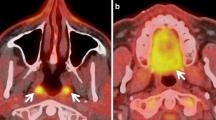Abstract.
The aim of this study was to evaluate the usefulness of 18F-FDG PET in the diagnosis and staging of primary and recurrent malignant head and neck tumours in comparison with conventional imaging methods [including ultrasonography, radiography, computed tomography (CT) and magnetic resonance imaging (MRI)], physical examination, panendoscopy and biopsies in clinical routine. A total of 54 patients (13 female, 41 male, age 61.3±12 years) were investigated retrospectively. Three groups were formed. In group I, 18F-FDG PET was performed in 15 patients to detect unknown primary cancers. In group II, 24 studies were obtained for preoperative staging of proven head and neck cancer. In group III, 18F-FDG PET was used in 15 patients to monitor tumour recurrence after radiotherapy and/or chemotherapy. In all patients, imaging was obtained at 70 min after the intravenous administration of 180 MBq 18F-FDG. In 11 of the 15 patients in group I, the primary cancer could be found with 18F-FDG, yielding a detection rate of 73.3%. In 4 of the 15 patients, CT findings were also suggestive of the primary cancer but were nonetheless equivocal. In these patients, 18F-FDG showed increased 18F-FDG uptake by the primary tumour, which was confirmed by histology. One patient had recurrence of breast carcinoma that could not be detected with 18F-FDG PET, but was detected by CT. In three cases, the primary cancer could not be found with any imaging method. Among the 24 patients in group II investigated for staging purposes, 18F-FDG PET detected a total of 13 local and three distant lymph node metastases, whereas the conventional imaging methods detected only nine local and one distant lymph node metastases. The results of 18F-FDG PET led to an upstaging in 5/24 (20.8%) patients. The conventional imaging methods were false positive in 5/24 (20.8%). There was one false positive result using 18F-FDG PET. Among the 15 patients of group III with suspected recurrence after radiotherapy and/or chemotherapy, 18F-FDG was true positive in 7/15 (46.6%) and true negative in 4/15 (26.6%). The conventional imaging methods were true positive in 5/15 (33.3%) and true negative in 4/15 (26.6%). One false negative (6.6%) and three false positive findings (20%) on 18F-FDG PET were due to inflamed tissue. The conventional imaging methods were false positive in three (20%) and false negative in three cases (20%). It is concluded that in comparison to conventional diagnostic methods, 18F-FDG PET provides additional and clinically relevant information in the detection of primary and metastatic carcinomas as well as in the early detection of recurrent or persistent head and neck cancer after radiotherapy and/or chemotherapy. 18F-FDG PET should therefore be performed early in clinical routine, usually before CT or MRI.
Similar content being viewed by others
Author information
Authors and Affiliations
Additional information
Received 8 December 2000 and in revised form 14 April 2001
Electronic Publication
Rights and permissions
About this article
Cite this article
Kresnik, E., Mikosch, P., Gallowitsch, H. et al. Evaluation of head and neck cancer with 18F-FDG PET: a comparison with conventional methods. Eur J Nucl Med 28, 816–821 (2001). https://doi.org/10.1007/s002590100554
Published:
Issue Date:
DOI: https://doi.org/10.1007/s002590100554




